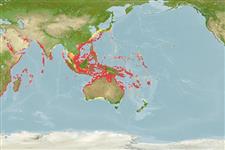Actinopterygii (ray-finned fishes) >
Perciformes (Perch-likes) >
Serranidae (Sea basses: groupers and fairy basslets) > Epinephelinae
Etymology: Aethaloperca: Greek, aithalos, -ou = soot, black, ash + Greek, perke = perch (Ref. 45335).
Environment / Climate / Range
Ecology
Marine; reef-associated; non-migratory; depth range 3 - 60 m (Ref. 68964), usually 3 - 60 m (Ref. 5222). Tropical, preferred 27°C (Ref. 107945); 36°N - 36°S, 27°E - 180°E (Ref. 5222)
Indo-West Pacific: Red Sea to South Africa and east to the Gilbert Islands. Probably found in all tropical islands of the Indian Ocean. Also reported from Persian Gulf (Ref. 68964). Recorded from Europa Island (MNHN 1992-0475, Ref. 33390).
Length at first maturity / Size / Weight / Age
Maturity: Lm ?, range 34 - ? cm
Max length : 60.0 cm TL male/unsexed; (Ref. 4787)
Dorsal
spines
(total): 9;
Dorsal
soft rays
(total): 17-18;
Anal
spines: 3;
Anal
soft rays: 8 - 9. Dark brown to black in color, occasionally with an orange cast (Ref 5222); color in market is dark brown without distinguishing marks (Ref. 89707); Inside of this grouper's mouth ranges from light pink to crimson. Juveniles have a white border on the caudal fin (Ref. 37816); further characterized by having relatively deep body; greatest depth 2.1-2.4 in SL; width 2.3-2.8 times in depth (Ref. 89707); truncate caudal fin; longest pectoral rays fifth or sixth (Ref. 90102); head length 2.5-2.7 times in SL; convex interorbital area; dorsal head profile steep, straight or slightly concave along the snout and distinctly convex from eye to dorsal fin; preorbital depth 6.5-9.2 times in HL; finely serrate preopercle, fleshy lower edge; smooth subopercle and interopercle or with minute serrae; opercle with three flat spines, middle one closer to the lower spine; upper edge of operculum convex; posterior nostril round or oval; maxilla reaches past eye; ventro-posterior corner of maxilla with distinct bony protuberance; slender supramaxilla; small canine at front of jaws, none elsewhere; 2-4 rows of small slender teeth at side of lower jaw; presence of palatine teeth; well-developed scaly flap of skin joining upper pectoral-fin rays to body; pectoral fins asymmetrical; pelvic fins subequal to pectoral fins, reaching to or beyond anus; caudal fin with 8 branched rays and 9 procurrent rays in upper part and 7 branched rays and 8 procurrent rays in lower part; body scales ctenoid, with auxiliary scales (Ref. 89707).
Found in coastal reefs and lagoons, often silty habitat (Ref. 48635), in or near caves and holes in the reef. Feeds mainly on small fishes (including Pempheris sp.), also on stomatopods (Pseudosquilla sp.) (Ref. 6448); and crustaceans (Ref. 37816). Preliminary data indicate that it spawns at any time of the year and matures (females?) at about 35 cm SL (Ref. 6448). Small juveniles mimic Centropyge vrolikii (Ref. 8631), and C. nox until they outgrow their model in size (Ref. 48635). Taken as part of the live reef food fish trade centered in China and In Hong Kong; occasionally found in markets (Ref. 89707).
Life cycle and mating behavior
Maturity | Reproduction | Spawning | Eggs | Fecundity | Larvae
Heemstra, P.C. and J.E. Randall, 1993. FAO Species Catalogue. Vol. 16. Groupers of the world (family Serranidae, subfamily Epinephelinae). An annotated and illustrated catalogue of the grouper, rockcod, hind, coral grouper and lyretail species known to date. Rome: FAO. FAO Fish. Synop. 125(16):382 p. (Ref. 5222)
IUCN Red List Status (Ref. 115185)
CITES (Ref. 94142)
Not Evaluated
Threat to humans
Harmless
Human uses
Fisheries: minor commercial; gamefish: yes
More information
ReferencesAquacultureAquaculture profileStrainsGeneticsAllele frequenciesHeritabilityDiseasesProcessingMass conversion
Tools
Special reports
Download XML
Internet sources
